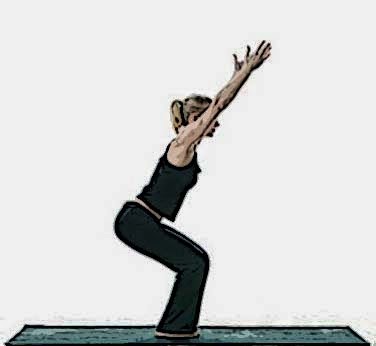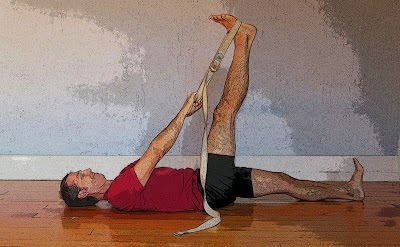by Baxter and Nina
The Simple Chair Twist is one of our five essential office yoga poses. It releases back muscles that are stiff or sore from sitting at a desk or from traveling, or from everyday activities that stress the back and increase the rotational mobility in your spine, such as gardening and painting. Twisting also helps nourish the spine—movement of the spine helps maintain the health of the discs—and it strengthens the bones themselves as your back muscles pull on the bony insertions of the spine. It also strengthens the oblique muscles of your core (and we could all use a little of that).
Traditional yoga teachers recommend twists for the health of your internal organs, improving circulation to and function of the abdominal organs, although no studies have been conducted to confirm this. And finally, for many of us, twists can release physical and emotional tension, providing relief from stress.
The Simple Chair Twist has the additional bonus of being accessible to almost everyone in any location, whether office chair, airplane seat, or even a car seat (except, as Baxter noted while sitting in Nina’s backyard, a 50s-style butterfly chair).
Baxter prescribes Simple Chair Twist for:
Keeping your thighs parallel to each other, lift your spine and turn toward the back of the chair, placing your hands on either side of the chair’s back. Inhale and create an inner lift from your sitting bones through the crown of your head. Then exhale and encourage the twist from your upper belly (above the navel) and chest. Continue lifting on your inhalation and twisting slightly deeper on the exhalation for about 1 minute. Then change sides and twist in the opposite direction. When you’ve finished the pose, pause for a moment to assess how the pose affected your body.
If you can’t sit on the side of your chair, you can sit facing forward as shown below.
As you twist to the right, place your right hand on the chair’s back and your bring your left hand across your right leg. To twist on the other side, simply switch your arm positions.
Cautions: With certain low back conditions (such as severe arthritis, bulging disc, spinal stenosis or sciatica) you should approach twisting cautiously and skip it entirely if it aggravates your symptoms. If you have osteoporosis, twist gently and don’t move through your full range of motion (stay within 50 to 70 percent). If you feel pain, please stop and when you get a chance, ask your yoga teacher for help.
The Simple Chair Twist is one of our five essential office yoga poses. It releases back muscles that are stiff or sore from sitting at a desk or from traveling, or from everyday activities that stress the back and increase the rotational mobility in your spine, such as gardening and painting. Twisting also helps nourish the spine—movement of the spine helps maintain the health of the discs—and it strengthens the bones themselves as your back muscles pull on the bony insertions of the spine. It also strengthens the oblique muscles of your core (and we could all use a little of that).
Traditional yoga teachers recommend twists for the health of your internal organs, improving circulation to and function of the abdominal organs, although no studies have been conducted to confirm this. And finally, for many of us, twists can release physical and emotional tension, providing relief from stress.
The Simple Chair Twist has the additional bonus of being accessible to almost everyone in any location, whether office chair, airplane seat, or even a car seat (except, as Baxter noted while sitting in Nina’s backyard, a 50s-style butterfly chair).
Baxter prescribes Simple Chair Twist for:
- general back tension
- stiffness
- people with balance issues (or who are unable to stand)
- certain low back conditions
- digestive difficulties (constipation or sluggishness)
- strengthening the oblique muscles
- arthritis of the spine
- people who engage in sports or other activities that involve rotation (all you golfers can restore symmetry to your body by twisting on both sides instead of one)
Keeping your thighs parallel to each other, lift your spine and turn toward the back of the chair, placing your hands on either side of the chair’s back. Inhale and create an inner lift from your sitting bones through the crown of your head. Then exhale and encourage the twist from your upper belly (above the navel) and chest. Continue lifting on your inhalation and twisting slightly deeper on the exhalation for about 1 minute. Then change sides and twist in the opposite direction. When you’ve finished the pose, pause for a moment to assess how the pose affected your body.
If you can’t sit on the side of your chair, you can sit facing forward as shown below.
As you twist to the right, place your right hand on the chair’s back and your bring your left hand across your right leg. To twist on the other side, simply switch your arm positions.
Cautions: With certain low back conditions (such as severe arthritis, bulging disc, spinal stenosis or sciatica) you should approach twisting cautiously and skip it entirely if it aggravates your symptoms. If you have osteoporosis, twist gently and don’t move through your full range of motion (stay within 50 to 70 percent). If you feel pain, please stop and when you get a chance, ask your yoga teacher for help.



























